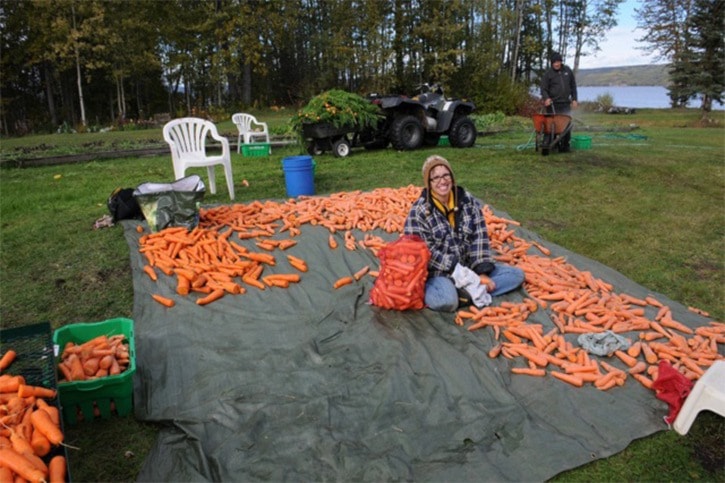Bob and Rosanne Murray provide fresh locally grown produce on their farm on the Southside. They say weather is one of the biggest challenges for producers in the area.
"Many new gardeners have phoned in frustration, and even tears, after a mid-July or August frost to say their gardens were hit with frost and were now black," said Bob.
“Growers have to use every trick in the book - frost covers, greenhouses, raised beds and looking for micro climates," he continued. "Once that is done, the next hurdle would be find the hardy plants and seeds that do well in our climate.”
Annie Van Metre raises beef and lamb on her ranch in Southbank. Although she says this year the weather hasn't been so bad, she had major losses in 2014 and 2015.
"I don't think there was a single month throughout the summer that there was no kind of frost," she said.
The unstable weather in the Lake District means that Van Metre frequently has to buy feed from different areas, which adds significantly to the her costs.
Samantha Finch, who runs a small homestead with an emphasis on polyculture techniques in the Lakes District, said building a greenhouse was the solution for her.
"For myself and the types of vegetables I like to grow it means I need greenhouses; these give me a longer season and more predictable climate to grow in."
Apart from the weather, local producers have also noticed an increase in wildlife issues over the past few years.
According to Bob Murray, wildlife increase costs, risks and challenges for production.
"The moose have started wintering in the backyard, eating and usually destroying the berry bushes and fruit trees" he described. "The deer are a problem in the summer, and when they decide to eat a product, they will destroy it."
Two years ago, Bob had planted about 300 different brassica plants; the second night in the garden, the deer ate over 75 per cent of the plants.
In addition, bears and foxes have also presented a threat.
"The bears were very rarely seen prior to 2008 but they now frequently visit the backyard and will destroy the fruit and berry crop in one visit," he said. "Also, foxes have become a huge nuisance, they are not afraid of people or dogs and will kill all the chickens, turkeys and other small animals in a matter of days."
"This has a huge impact on the cost of production," he continued. "We are having to put up more fences, better pens for the small animals, cattle guards, electric fencing, guard dogs and time to chase or deal with these wildlife issues."
John Stevenson, regional agrologist with the B.C. Ministry of Agriculture, told the board of directors of the Regional District of Bulkley-Nechako last week that the ministry has formed a regional task force with the Skeena Regional Cattlemen's Association to find ways to address wildlife issues.
The task force is now planning to offer a workshop in the fall to provide tips and strategies for producers in the region.
Marketing their products also a challenge for local producers
Some producers in the Lakes District say they have difficulties marketing their products and connecting with consumers.
Brian and Shirley Wiebe have a family-run farm on the Southside providing hormone free beef. They sell their product mostly through word of mouth and social media.
Brian said that although many people are willing to pay the extra amount for high-quality beef, he said their biggest challenge has been to market their product.
"We have consumers out there that want better choices for themselves and their families, they just don't know how to access it," he said. "I am not a marketer, therefore I have a difficult time pushing my product on people all year."
Bob and Rosanne Murray, who provide fresh locally grown produce on their farm on the Southside, agree that getting their product to consumers has been a challenge.
Bob said the Regional District of Bulkley-Nechako's Facebook page - Connecting Consumers and Producers -, as well as the Lakes District Local Foods' Facebook page are good first steps to help promote local producers.
The Village of Burns Lake is currently developing strategies to help connect local producers and consumers.
One of the strategies included in the village's economic development plan is to establish a local food producer roundtable to encourage dialogue on the opportunities and challenges of producing food in the area.
Krystin St. Jean, the village's economic development officer, said the local producer roundtable will help the village and local producers understand what opportunities exist in the area. It will also help them find methods to sell food produced in Burns Lake to new and larger markets.
"The agriculture industry is growing in British Columbia in both a local and global context," said St. Jean. "There is a great opportunity for current and future agricultural sector businesses in our community to grow their business and help diversify the local economy."
According to Derek Feldman, Priestly Meats, who sells beef, chicken and turkey just east of Burns Lake, there's plenty of opportunity in the area if people are willing to work hard.
"If you're willing to do the work, the market is there and it's pretty easy to find," he said. "It's pretty satisfying when you're able to supply people with something they want and they are happy about it."
